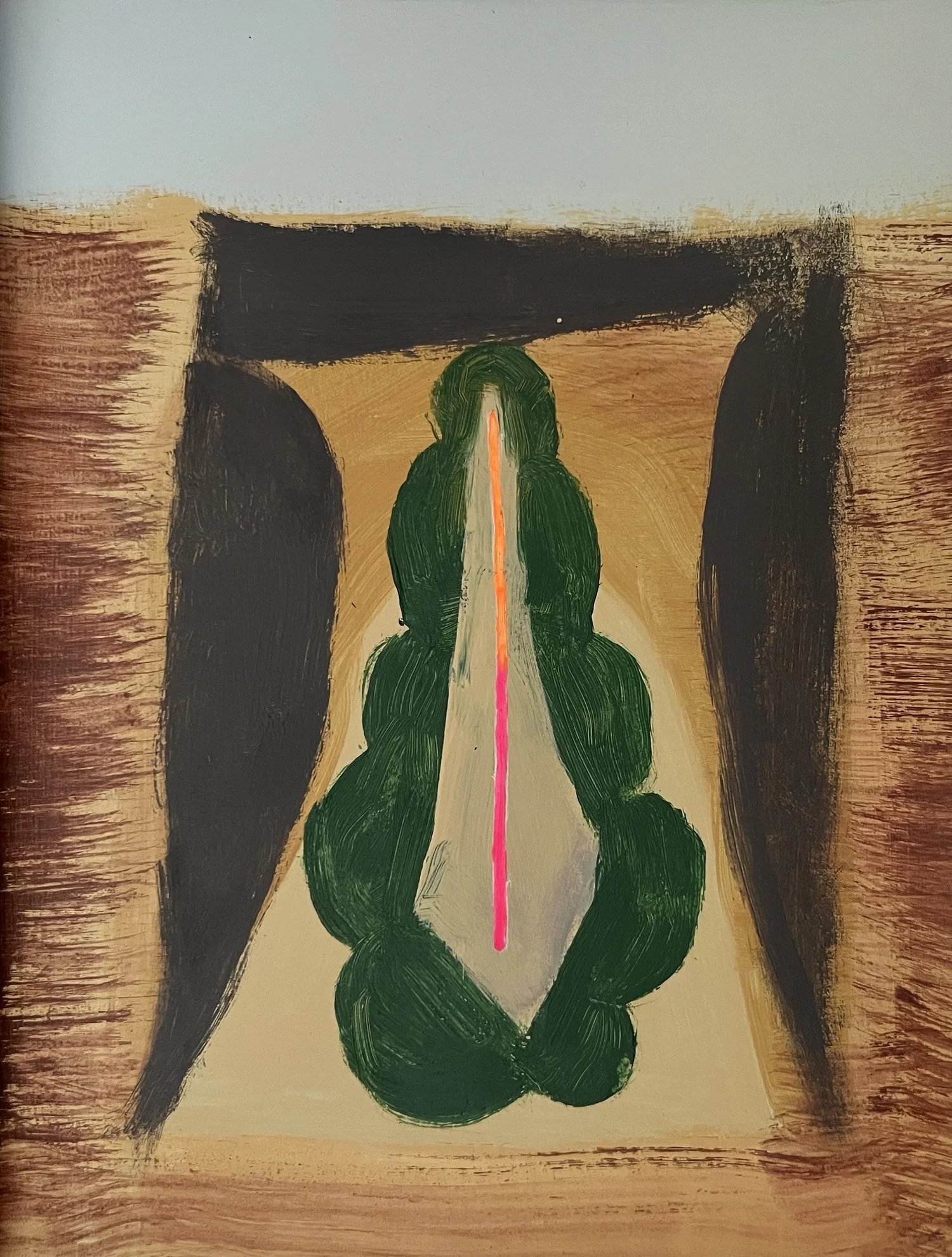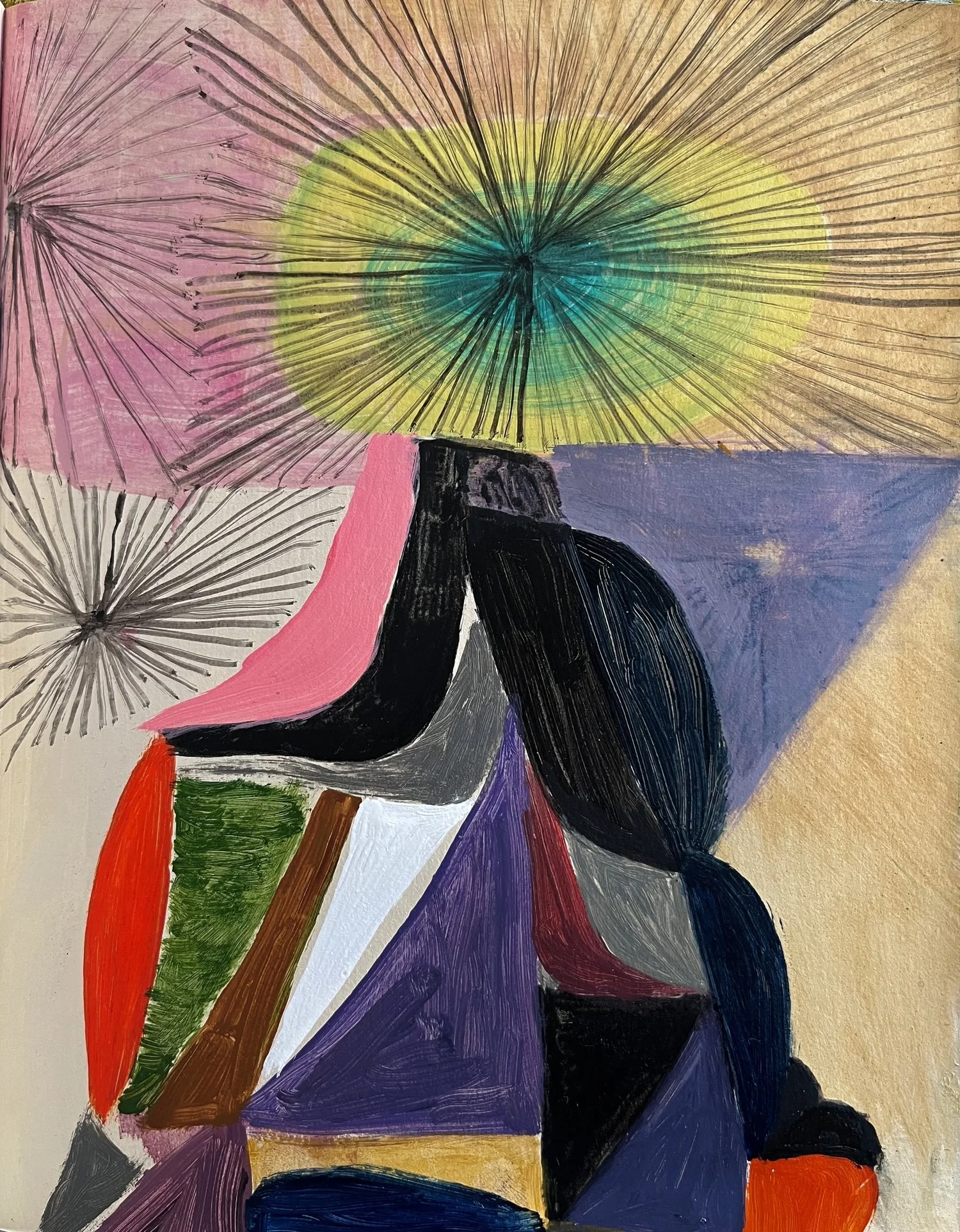Cover Image Ekasala T, Full Face Helmet (2023)
Produce a full draft of your Critical Review as either a 1,000 word essay, or 8 minute presentation.
Title: HOW CAN DRAWING ADD AGENCY TO ABSTRACT PAINTING?
Drawing at its best is not what your eyes see but what our mind understands. (Millard Sheets)
Through practice and research I have examined a number of abstract paintings which originate from the observation of the visible world. I found that several appear to be forged through the elements of drawing. It may not be a conscious act in many cases, but an intrinsic approach that has naturally developed over a course of time.
Drawing has a history as a preparatory discipline, but now informal practice is more acceptable it is less documented as a necessary foundation to painting.
This text is a process of exploration that might open up more questions than it answers!
Drawing creates a foundation of observational skill in using the formal elements – line, tone, composition etc. Elements that enable the 2 artists discussed in this text, Terry Ekasala and Claire Kirkup, to demonstrate a narrative within their work.
DRAWING RESURRECTED THROUGH PAINT
Terry Ekasala, is an American contemporary painter. Her work evolved from figurative to abstract and she currently makes small and large scale abstract paintings in her Vermont studio.
Claire KirKup, also an abstract painter, who originates and lives in Australia. As well as the figure, she uses influences from nature as starting points for intuitive large scale paintings.
Both artists are abstract painters, with early roots in representational art. This representational debut into abstraction is evident with many abstract painters, Joan Mitchell, Amy Sillman, Jackson Pollock, Willem de Kooning……Their early work shows examples of high academic drawing skill that in reflection influences the brush work and knowledge of composition in their evolved abstract paintings.
Fig.1 de Kooning W, Untitled Clamdigger (1970)
Fig.2 Pollock J, Echo: Number 25 (1951)
Fig.3 Mitchell J, Sketchbook (Circa 1967)
Ekasala and Kirkup share an intuitive approach to painting, their style is spontaneous. They both use the process of mark making, layering, and highlighting, to create nuances and informed areas to stimulate the appearance of something recognisable. Their work differs in composition, Ekasala prefers to use the boundaries of the canvas or paper to naturally frame her work. And Kirkup blurs the boundary between the natural edge of the canvas and beyond.
Ekasala excavates her paintings to their essence to capture her subject or intention. Whereas Kirkup builds up her content.
On closer inspection of Fig. 4, 5, 6, and 7 the tempo of brush strokes, layers of translucent and opaque paint, and drawn lines, appear to happen intuitively. But they are informed. They persist because they are relevant to the overall narrative of the piece. Drawing is resurrected through the creation of the painting and vis versa.
By simulating the structure of recognisable elements, the viewers intuition is also at play when connecting these forms. This type of communication with paint would not be possible without the foundation of drawing.
Fig.4 Ekasala T, Secret Entrance (2024)
Fig.5 Ekasala T, This Is The Day (2023)
Fig.6 Kirkup C, Folding Imperfections (2021)
Fig.7 Kirkup C, Chomley Avenue (2021)
Ekasala has expressed in interviews how drawing began as a focal point, and gave her purpose. She had a desire to investigate, and create solutions. She used drawing as a technique to initiate these intentions and continuously worked on improving her technique.
A background and a respect of drawing can render a painting so “working all the elements involved so they come together (even in chaos) to create a balanced, pleasing and sometimes emotional piece”. (Ekasala 2019)
In 1967 Richard Serra produced Verb List, an articulate list of actions to relate to the artistic process, but we have come to know the word ‘Draw’ or ‘Drawing’ as a restricted literal term whether in its form as a noun or a verb. A drawing being something made on paper with a drawing tool such as a pencil or pen. But in reality we recognise drawing as something much more diverse, which informs the archeology of successful paintings.
Fig.8 Serra R, Verb List (1967)
It is useful to consider Serra’s ‘Verb List’ and the theory that drawing can be an act executed in a range of mediums and physicalities.
Foundational drawing uses skill in observation and the use of tone, light, and shadow, etc. The act of erasing and manipulating facilitates a process of trial and error, reassessment, decision making and material editing. Also, immersing the self, by using more than the hand and wrist to draw increases the artists immersion within the art.
Observation through drawing enables the artist to access the previously unseen. It opens up an intuitive dexterity. It becomes more than an academic exercise. It becomes an action and reaction, something that bridges the parallels between the observatory and intuitive application of the paint.
The intention of drawing, strengthens the artists relationship with their subject and materials. It brings a truth and complexity to the paintings.
Arguably observational painting does this also, but I refer to Serra’s ‘Drawing is a Verb’ theory to frame the concept that drawing is an action made with a multitude of mediums.
Drawing is an awareness that exists between the disciplines, and it is often the intersections in art that create the areas of most interest.
Fig.9 Mitchell J, La Vie en Rose (1979)
THE FACTORY OF OUR HANDS
In 2017 Amy Sillman presented an artists talk as part of Draw In: Conversations and Lectures on Drawing and Its Resonances for The Menil Collection.
Within her lecture she described how drawings relevance is not just a preparatory sketch, but at the conceptual heart of her work. Her work is a convincing example of drawing existing as an act, rather than confined to its literal means. She describes herself as a ‘Drawer’ rather than a painter, which she would be most likely labeled as.
This revelation acts to cement the practicality of the theory that drawing instrumentality affects painting. It can be as subtle as the character within individual marks, or the manifestation of many gestures combined.
Fig.10 Sillman A, Frieze For Venice (2022)
She paraphrased Merleau-Ponty to demonstrate the range that drawing has, ‘Drawings genesis is from that feverish thing our bodies. Facture is formed by the literal factory of our hands, but it comes out of the hands and body to form a visible rhetoric. But not one of logic, rather a style of making intensified by transformation and displacement’. (Amy Sillman paraphrasing Merleau Ponty).
THE WAY ONE SEES IT
In the same way we analyse and excavate ideas from looking at a piece of art, we can excavate the verb ‘To draw’. It is greater than the sum of its parts. To understand and accept drawing is an action, we in turn can accept that it becomes to all practices of art. It evolves the skill of the artist, and also expands the viewer’s experience with painting. Its presence enables you to create or view the work with fresh eyes.
Let whoever may have attained to so much as to have the power of drawing know that he holds a great treasure. (Michelangelo)
List of Images
Cover Image Ekasala, T. (2023) Full Face Helmet. [Acrylic on archival paper, photo edited with Hipstamatic] At:https://www.terryekasala.com/work#/works-on-paper/ (Accessed 10.07.2025).
Fig.1 Serra, R. (1967) Verb List. [Pencil on paper] At:https://www.moma.org/collection/works/152793?sov_referrer=theme&theme_id=5739 (Accessed 10.07.2025).
Fig.2 de Kooning, W. (1970) Untitled, Clamdigger. [Charcoal on paper] At:https://www.drawingsandnotes.com/willem-de-kooning(Accessed 10.07.2025).
Fig.3 Pollock, J. (1951) Echo: Number 25. [Enamel on canvas] At:https://www.artforum.com/features/first-among-sequels-jackson-pollocks-late-work-228009/ (Accessed 10.07.2025).
Fig.4 Mitchell, J. (Circa 1967) Sketchbook. [Water soluble wax crayon, wash, fibre tipped pen on paper] At:https://www.joanmitchellfoundation.org/journal/six-joan-mitchell-sketchbooks-digitized (Accessed 10.07.2025).
Fig. 5 Ekasala, T. (2024) Secret Entrance. [Acrylic on archival paper] At:https://www.terryekasala.com/work (Accessed 10.07.2025).
Fig.6 Ekasala, T. (2023) This Is The Day. [Acylic on archival paper] At:https://www.terryekasala.com/work (Accessed 10.07.2025).
Fig.7 Kirkup, C. (2021) Folding Imperfections. [Acylic, vinyl and gouache on paper] At:https://www.clairekirkup.com.au/hot-springs-2018-1 (Accessed 10.07.2025).
Fig.8 Kirkup, C. (2021) Chomley Avenue. [Acylic on canvas] At:https://www.clairekirkup.com.au/hot-springs-2018-1 (Accessed 10.07.2025).
Fig.9 Mitchell, J. (1979) La Vie en Rose. {Oil on canvas] At:https://www.joanmitchellfoundation.org/joan-mitchell/key-works(Accessed 10.07.2025).
Fig. 10 Sillman, A. (2022) Frieze For Venice. At:https://www.visit-venice-italy.com/biennale-venice/2022/amy-sillman-venice-biennale-art-exhibition.html (Accessed 10.07.2025).
Bibliography
MoMA: Richard Serra – Drawing Is A Verb. At:https://www.moma.org/calendar/galleries/5739 (Accessed 09.07.2025).
Terry Ekasala: Bio. (2019) At:https://www.terryekasala.com/bio (Accessed 09.07.2025).
Claire Kirkup: Bio. (2018) At:https://www.clairekirkup.com.au/artist-statement(Accessed 09.07.2025).
You Tube: The Menil Collection – Conversation with Amy Sillman: Drawing in the Continuos. At:https://www.google.com/search?client=safari&rls=en&q=amy+sillman+drawing&ie=UTF-8&oe=UTF-8#fpstate=ive&vld=cid:6fde4294,vid:BLOgc466nRk,st:0 (Accessed 09.07.2025).
Bold Journey: Meet Terry Ekasala (2024) At:https://boldjourney.com/meet-terry-ekasala/ (Accessed 05.08.2025).
The English Room: Artist Spotlight Series: Terry Ekasala (2019) At:https://www.theenglishroom.biz/artist-spotlight-series-terry-ekesala/(Accessed 05.08.2025).










